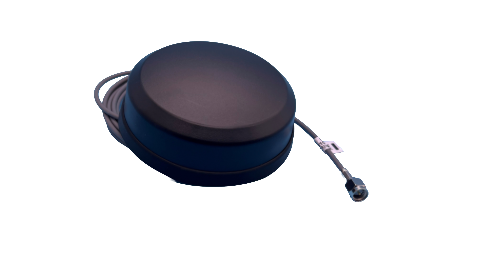
4G and 5G antennas – why use a puck antenna? 5 things to consider
Share
4G puck antennas and 5G puck antennas are common choices for both fixed and mobile antennas to complement 4G and 5G routers. What are the key considerations for choosing the correct puck antenna for your application? We look at some of the answers here.
Frequency Support
Given the sunset of 2G and 3G in some markets, many puck antennas need to operate at 4G and 5G frequencies to support most applications. Therefore, attention should be paid to what frequencies the puck antenna can function at. For example, a 4G puck antenna might operate at 700-2700 MHz which covers most 4G bands (and indeed some 5G bands), but does not support the 3400-3800 MHz 5G band. Some of the smaller puck antennas have more limited frequency support and this should be stated on the datasheet.
Mounting
There are a number of mounting options for 4G and 5G puck antennas – most typically, permanent mount via a threaded stud at the bottom of the antenna, magnetic mount or adhesive or tape mount.
Permanent mount puck antennas are ideal for long term deployment in either fixed or mobile applications. A hole is drilled into the mounting surface and the stud that the bottom of the antenna is passed through the hole and held in place with a nut and washer. This mounting method is usually robust and prohibits accidental removal of the antenna.
Magnetic mount puck antennas can be used in fixed or mobile applications mounting onto a metal surface and ideal for deployments where drilling a hole or permanently mounted antennas are undesirable. Consideration must be given to the strength of the magnet base in mobile environments depending on the speed of the application (at high speeds some magnetic antennas can detach).
Size vs Gain
Often, for many customers, 4G puck antenna and 5G puck antenna size can be critical. Especially, in high visible installations, customers want very low profile antennas to reduce risk of damage or vandalism or due to the size of the enclosure or device that the puck is installed on there is a limit of the size of the antenna footprint. As a rule of thumb, the smaller the puck antenna, the lower the gain. Typically, but not in all cases, larger puck antennas exhibit better RF performance and this can be the difference between a somewhat functional and a reliable antenna installation.
As an example with 2 very good low profile antennas, the AllDisc low profile dome antenna (D138 x H55 mm) when mounted on a groundplane offers a peak gain of 4.5 dBi to 6.5 dBi from 700 to 3800 MHz. In comparison, the smaller SmartDisc antenna (D98 x H27.5mm) on a groundplane offers a gain of 1.5 dBi to 6 dBi across the bands with the lower 700-960 MHz band delivering much lower gain that the AllDisc. Therefore, if it is possible to deploy the AllDisc antenna as a low profile antenna, the installation will be rewarded with higher RF performance.
Weatherproofing
Should you puck antenna application require long term outdoor deployment, then weatherproofing is a key factor. It is good to look for IP ratings (Ingress Protection), and provided your antenna is not going to be submerged, a IP66 or above rating should be sufficient for most installations. Look for weatherproofing features such as a robust rubber gasket at the bottom of permanent mount antennas, for example.
Cable/Connector options
As always, the suitability of antenna for your application is crowned by the cable type, length and connector. Check for the cable length option that most suits your installation and try not to use an antenna with excess cable (i.e. coiled excess cable sitting next to the router) as this equates a little unnecessary signal loss in that unused cable). Many 4G puck antenna and 5G puck antenna offerings will be able to specify 50cm, 1M, 2M or 2.5M integrated cables. Look for an antenna with a cable length that fits your installation.
For more information on 4G and 5G puck antennas, check out our 4G / 5G antennas page or if you have a specific questions, please send us an e-mail to sales@connextechnologies.co.uk or call us and we will do our best to help.
